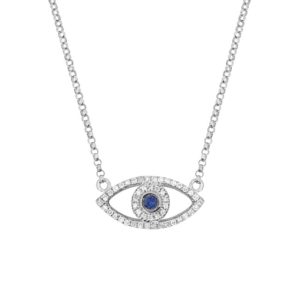Evil Eye: Who in this day hasn’t heard of the evil eye? It’s everywhere. But what exactly is it and why does it have so much popularity in this day and age? We will look into all this and see why we have a sign that we’re not willing to let go of (me in particular!) A sign that has become one of the strongest symbolic images in the world.
The meaning is the idea that there are people who can place a bad eye on you. This bad eye is thought of as a look given to inflict harm, suffering or some form of bad luck on a person. These ill feelings, whether done consciously or unconsciously, may still put a jinx on a person or item, causing something bad to happen to them. It is because of this that throughout countless stages of human history man has searched for the assistance of magic objects, called talismans, to defy these evil forces.
Where did the evil eye start?
The first recorded picture was over 5000 years ago by the Mesopotamians. They lived in the land corresponding mostly to today’s Iraq, but also parts of modern day Iran, Syria and Turkey. It was in this area that clay tablets were found with the image of the evil eye carved into them. Perhaps this is why belief in the evil eye is strongest in the Middle East.
Who believes in it?
The belief is worldwide. However, the belief of how the evil eye can affect you are not tantamount. Here are a few examples of how belief in the evil eye differs throughout the world.
India:
It is believed that the eye is the most powerful source on the body which can give off energy. There is no surprise that if the eye is capable of sending out evil, it will be the strongest form of evil and need protection against. It is believed that the evil eye can be brought about by looks of admiration as well as looks of evil. Remind me to be cautious about looking people directly in the eye the next time I’m talking to someone!
Brazil:
The evil eye is better known as the “fat eye”. It is believed in Brazil, and other parts of South America, that compliments which are given and not sincere can bring about the evil eye. The same is not true for sincere compliments. It does make me wonder how much more honest people may be in South America!
Europe:
In Europe, that malicious looks or looks of greed or envy have the power to bring about the evil eye. In different parts of Europe, different signs are to be the indicator of whether a person held an evil eye or not. Such signs include rare colored eyes, as the Germans believed red eyes were the sign, or squinty eyes as was believed to be a sign of the evil eye in Ireland. Those who had a unibrow, were believed to hold the evil eye. Imagine being a red eyes, squinting, unibrowed girl, there was no hope!
Popularity of the charm
In today’s world which, it is believed that too much fame, fortune, success or praise may be the cause for bringing one’s own downfall. Perhaps that’s why over the years evil eye charms have collected so much attention in the public eye. They have been worn in public by celebrities such as Cameron Diaz, Brad Pitt, Kim Kardashian and Rhianna. But perhaps the most popular example was Lindsay Lohan when she was photographed wearing evil eye jewelry when in court adding a sense of her plea for support during the troubling times. Maybe there is something more to this charm than meets the eye!
How to escape the evil from the eye
The evil eye charm believed to create a level of protection and reflect the harmful power of the evil look. If your evil eye charm cracks or breaks, it has done it’s job of protecting you against some form of bad. At that point it should be replaced.
Why protect oneself?
We may not know when a person is giving us the “evil eye” (scary, I know!) This is why so many people make it their jewelry of choice. They ensure that they are always protected. When a person wears or carries with them an evil eye, they will be guarded against bad things. These bad things may be willed onto them by others. The charm is thought of as a good luck charm as it carries a source of protection.


